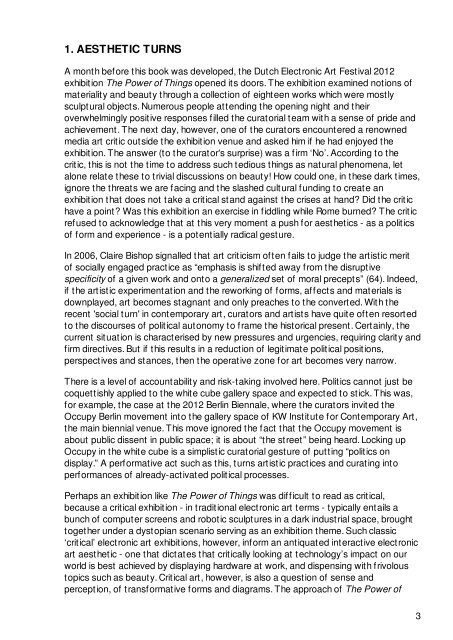New Aesthetic New Anxieties - Institute for the Unstable Media
New Aesthetic New Anxieties - Institute for the Unstable Media
New Aesthetic New Anxieties - Institute for the Unstable Media
You also want an ePaper? Increase the reach of your titles
YUMPU automatically turns print PDFs into web optimized ePapers that Google loves.
1. AESTHETIC TURNSA month be<strong>for</strong>e this book was developed, <strong>the</strong> Dutch Electronic Art Festival 2012exhibition The Power of Things opened its doors. The exhibition examined notions ofmateriality and beauty through a collection of eighteen works which were mostlysculptural objects. Numerous people attending <strong>the</strong> opening night and <strong>the</strong>iroverwhelmingly positive responses filled <strong>the</strong> curatorial team with a sense of pride andachievement. The next day, however, one of <strong>the</strong> curators encountered a renownedmedia art critic outside <strong>the</strong> exhibition venue and asked him if he had enjoyed <strong>the</strong>exhibition. The answer (to <strong>the</strong> curator's surprise) was a firm ‘No’. According to <strong>the</strong>critic, this is not <strong>the</strong> time to address such tedious things as natural phenomena, letalone relate <strong>the</strong>se to trivial discussions on beauty! How could one, in <strong>the</strong>se dark times,ignore <strong>the</strong> threats we are facing and <strong>the</strong> slashed cultural funding to create anexhibition that does not take a critical stand against <strong>the</strong> crises at hand? Did <strong>the</strong> critichave a point? Was this exhibition an exercise in fiddling while Rome burned? The criticrefused to acknowledge that at this very moment a push <strong>for</strong> aes<strong>the</strong>tics - as a politicsof <strong>for</strong>m and experience - is a potentially radical gesture.In 2006, Claire Bishop signalled that art criticism often fails to judge <strong>the</strong> artistic meritof socially engaged practice as “emphasis is shifted away from <strong>the</strong> disruptivespecificity of a given work and onto a generalized set of moral precepts” (64). Indeed,if <strong>the</strong> artistic experimentation and <strong>the</strong> reworking of <strong>for</strong>ms, affects and materials isdownplayed, art becomes stagnant and only preaches to <strong>the</strong> converted. With <strong>the</strong>recent 'social turn' in contemporary art, curators and artists have quite often resortedto <strong>the</strong> discourses of political autonomy to frame <strong>the</strong> historical present. Certainly, <strong>the</strong>current situation is characterised by new pressures and urgencies, requiring clarity andfirm directives. But if this results in a reduction of legitimate political positions,perspectives and stances, <strong>the</strong>n <strong>the</strong> operative zone <strong>for</strong> art becomes very narrow.There is a level of accountability and risk-taking involved here. Politics cannot just becoquettishly applied to <strong>the</strong> white cube gallery space and expected to stick. This was,<strong>for</strong> example, <strong>the</strong> case at <strong>the</strong> 2012 Berlin Biennale, where <strong>the</strong> curators invited <strong>the</strong>Occupy Berlin movement into <strong>the</strong> gallery space of KW <strong>Institute</strong> <strong>for</strong> Contemporary Art,<strong>the</strong> main biennial venue. This move ignored <strong>the</strong> fact that <strong>the</strong> Occupy movement isabout public dissent in public space; it is about “<strong>the</strong> street” being heard. Locking upOccupy in <strong>the</strong> white cube is a simplistic curatorial gesture of putting “politics ondisplay.” A per<strong>for</strong>mative act such as this, turns artistic practices and curating intoper<strong>for</strong>mances of already-activated political processes.Perhaps an exhibition like The Power of Things was difficult to read as critical,because a critical exhibition - in traditional electronic art terms - typically entails abunch of computer screens and robotic sculptures in a dark industrial space, broughttoge<strong>the</strong>r under a dystopian scenario serving as an exhibition <strong>the</strong>me. Such classic‘critical’ electronic art exhibitions, however, in<strong>for</strong>m an antiquated interactive electronicart aes<strong>the</strong>tic - one that dictates that critically looking at technology’s impact on ourworld is best achieved by displaying hardware at work, and dispensing with frivoloustopics such as beauty. Critical art, however, is also a question of sense andperception, of trans<strong>for</strong>mative <strong>for</strong>ms and diagrams. The approach of The Power of3








